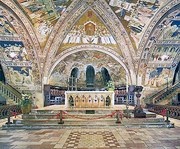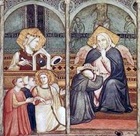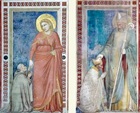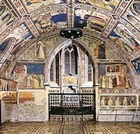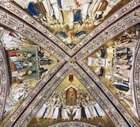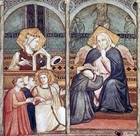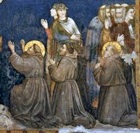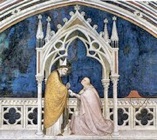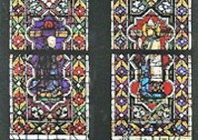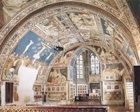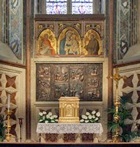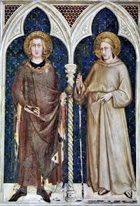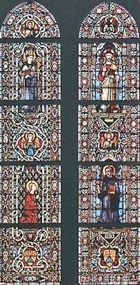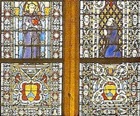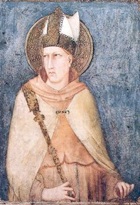Pope Celestine V (July -December, 1294)
The protracted papal conclave (1292-4) that followed the death of Pope Nicholas IV moved from Rome to Perugia in the autumn of 1293, and finally reached a conclusion in July 1294: it elected an aged Benedictine hermit, Pietro del Morrone as Pope Celestine V. Cardinal Jacopo Stefaneschi, in his "Opus Metricum", recorded the circumstances in which this election occurred:
-
✴King Charles II of Naples arrived in Perugia in March 1294 to press the cardinals to reach a conclusion, but he was not immediately successful.
-
✴The shock of the unexpected death of Giovanni Gaetano Orsini, the young brother of Cardinal Napoleone Orsini (see below), caused him to strive to settle his differences with the other cardinals participating in the conclave. Napoleone Orsini commissioned the Cappella di San Nicolò (see below) as a funerary chapel for his brother.
-
✴When Pietro del Morrone sent the cardinals a letter warning them that they would incur the wrath of God if they did not quickly elect a pope, Cardinal Latino Malabranca Orsini, the aged and ill dean of the College of Cardinals cried out: "In the name of the Father, the Son, and the Holy Ghost, I elect brother Pietro del Morrone."
In this unusual atmosphere of harmony and heightened piety, the cardinals duly accepted his nomination. The astounded Pietro del Morrone was duly brought from his hermitage in the Abruzzi and consecrated as Celestine V, at l’ Aquila, in the presence of Charles II.
Charles II immediately took charge of Celestine V, whom he installed in the Castel Nuovo, Naples. Celestine V badly missed his hermitage and sought resignation. Cardinal Benedetto Caetani, the future Pope Boniface VIII) advised him that this was canonically possible, and he duly resigned.
Celestine V and the Spiritual Franciscans
A group of zealous Franciscans (known as the zelanti) in the Marches, led by Brothers Liberato and Angelo da Clareno, had been imprisoned in ca. 1279, because of their rebellion against the established practices of their Order. They had languished in jail until 1289 , when the new Minister General, Brother Raymond de Gaufredi had freed them and sent them as missionaries to Armenia.
When the exiled zelanti returned to Italy in 1294, they received a frosty welcome from the Franciscan establishment in the Marches. Raymond de Gaufredi therefore suggested that Brothers Liberato and Angelo should seek protection for their brothers from Celestine V at l’ Aquila. He readily took them under papal protection and absolved them from their vows of obedience to their erstwhile superiors. He declared that they were to be known as the Poor Hermits of Pope Celestine, and instructed the monks of his own congregation to put some of their hermitages in southern Italy at the the disposal of what was, in effect, a new order. He formally designated Brother Liberato as their leader and appointed Cardinal Napoleone Orsini (see below) as their Cardinal Protector.
Not surprisingly, the zelanti recognised in Celestine V the “angelic pope” who would reform the Church, replacing corruption and internal strife with goodness and justice. His election seemed to herald the Age of the Holy Spirit that had been promised in the prophecies of Joachim da Fiore. Their hopes were of course in ruins when he subsequently resigned.
Pope Boniface VIII (1294-1303)
When Celestine V resigned, the relieved the cardinals quickly elected Cardinal Benedetto Caetani as Boniface VIII. He revoked all the privileges the Celestine V had granted "in the fullness of his simplicity", and imprisoned him (probably in reasonably humane conditions) until his death in 1296.
Boniface VIII was well-disposed towards the Franciscans: he created a three Franciscan cardinals and a number of Franciscan bishops, including, in 1296, Bishop Tebaldo Pontano of Assisi (see below). While there is no evidence that he was a direct patron of San Francesco, he did issue two bulls in January 1296 that would have increased the flow of pilgrims:
-
✴in “Ante thronum”, he granted indulgences for those visiting San Francesco on the feast of St Francis; and
-
✴in “Licet is”, he granted indulgences to those visiting the church on other days, provided that they made confession.
These seem to have been the last papal privileges granted to San Francesco until 1392.
In his account (1310) of the granting of the Portiuncula Indulgence, Bishop Tebaldo (see below) asserted that Boniface VIII sent legates to the Portiuncula to preach the Indulgence, an event that probably took place in 1298. This must have added to the funds generated by the papal indulgences for San Francesco itself, and these funds probably helped the friars to finance the extensive remodelling of what had been (before the demolition of the choir screen) the friars’ choir in the Lower Church. (The redecoration of this part was carried out in three phases (defined below) during the first two decades of the 14th century - see below).
The reign of Boniface VIII accelerated towards is disastrous end from 1296-7:
-
✴His relations with King Philip IV of France were strained by a number of disputes, mostly about the taxation of the French clergy.
-
✴A member of the Colonna family stole a convoy of papal treasure heading or Rome in 1297, which led to the excommunication of the Cardinals Giacomo and Pietro Colonna. They duly sought the protection of the Philip IV.
-
✴In 1302, Boniface VIII issued the bull “Unam sanctam”, in which he declared that both spiritual and temporal power were under the pope's jurisdiction, and that kings were subordinate to the power of the Church. In response, Guillaume de Nogaret, the chief minister of Philip IV, denounced Boniface as a heretical criminal to the French clergy. In 1303, Boniface VIII excommunicated Philip IV and Nogaret .
On 7th September, 1303, Nogaret and Sciarra Colonna attacked Boniface VIII at Anagni. He was badly beaten and held captive for three days. While he survived this traumatic experience, it probably contributed to his death shortly afterwards.
Boniface VIII and the Spiritual Franciscans
Boniface VIII was initially inclined to tolerate the zelanti but he reacted against them when it was pointed out to him that many of them denied his right to the papacy. In 1295, he deposed Brother Raymond de Gaufredi, the Franciscan Minister General, whom he regarded as too tolerant of this wing of the Order. Brothers Liberato and Angelo and some of their associates wisely fled to an island in what is now Greece. When Boniface VIII asked the Patriarch of Constantinople to arrest them, they moved to Thessaly.
Brother John of Morrovalle
Boniface VIII initially appointed Cardinal Matthew of Acquasparta as a temporary replacement for Raymond de Gaufredi. He then officiated over the General Chapter (1296) at Anagni, at which Brother John of Morrovalle was elected. According to Giorgio Vasari, it was Brother John of Morrovalle who first called Giotto to Assisi (see below).
Brother John of Morrovalle received two important men into the Order in St Peter’s, Rome on Christmas Eve, 1296:
-
✴the future St Louis of Toulouse (see below); and
-
✴Count Guido I of Montefeltro. Celestine V had accepted the contrition this erstwhile excommunicated Ghibelline, in 1294. Guido then decided to end his days as a Franciscan. Boniface VIII sent him the cloth for his habit. He then spent a short time at Santa Maria Aracoeli, Rome, before moving to the Sacro Convento. He died in September 1298 at Ancona, apparently en route for the Holy Land. Early sources allege that he was buried in San Francesco, but this is incorrect.
Igino Supino (referenced below) tentatively suggested that:
-
✴the aged friar kneeling before the allegory of Obedience in the frescoes in the vaults above the high altar of the Lower Church (see below) was Guido I of Montefeltro; and that
-
✴the figures on the left were Brother John of Morrovalle (in red) and St Louis of Toulouse.
Boniface VIII created John of Morrovalle as Cardinal Bishop of Porto in 1302. He therefore resigned as Minister General at the General Chapter (1304) at Assisi. Cardinal Matteo Rosso Orsini, the long-standing Cardinal Protector, died in 1305, and Cardinal John of Morrovalle was given this appointment in 1307.
Bishop Tebaldo Pontano
The Franciscan Bishop Tebaldo Pontano da Todi of Assisi had held episcopal office in the Kingdom of Naples (at Castellammare di Stabia and then Terracina) before Boniface VIII appointed him as Bishop of Assisi in 1296. The Cappella di Santa Maria Maddalena, which the first chapel to be built off the nave of the Lower Church, was built at about this time: Bishop Tebaldo may have commissioned it: he certainly commissioned its decoration by Giotto and his workshop soon after its completion.
The dedication of the chapel was probably inspired by the fact that the future King Charles II of Naples had discovered what he insisted were relics of St Mary Magdalen at Saint-Maximin, in his county of Provence, in 1279. After he assumed the throne in 1288, he promoted her cult throughout the kingdom. In the bull (1295) in which he endorsed the building of a new basilica at Saint-Maximin and the settlement there of a community of Dominicans, Pope Boniface VIII also endorsed the identification of the relics, notwithstanding the earlier claims of Vézelay.
The frescoes in this chapel mostly depict scenes from the life of St Mary Magdalene. Bishop Tebaldo appears twice among them:
-
✴in a fresco on the right wall, he wears his Franciscan habit, kissing the hand of St Mary Magdalene; and
-
✴in a fresco on the left wall, he is shown as a bishop, kneeling before St Rufinus.
The recent restoration of these frescoes has reinforced their attribution to Giotto and his workshop. They are dated on stylistic grounds to a period following his work in the Arena Chapel, Padua (ca. 1305); it is possible that the work was financed by the loan that Palmerino di Guido repaid in Assisi in 1309 on his own behalf and that of “Giotto Bondoni of Florence”. As such, they belong to Phase II of the redecoration programme (see below).
Bishop Tebaldo wrote the definitive account of the granting of the Portiuncula Indulgence in 1310, in an attempt to refute the arguments of “the ignorant the jealous and contentious who try to destroy, suppress and condemn it”. This work was clearly intended to attract pilgrims to the Portiuncula, which would have had the effect of enhancing the funs available for the redecoration of the Lower Church.
[In 1319, when the Ghibelline Muzio di Francesco took power in Assisi and stole the papal treasure that was stored at San Francesco (see below), Pope John XXII (see below) held Bishop Tebaldo personally accountable and confiscated the vestments that he had donated to the chapel. This indicates that the chapel was complete and in use by that time].
[Bishop Tebaldo was presumably buried in this chapel when he died in 1329 (despite the fact that Assisi was still under papal interdict), but no trace of his tomb survives.]
Cardinal Napoleone Orsini
As noted above, there seem to have been no papal initiatives in relation to San Francesco for much of the 14th century. The friars thus became dependent on other patrons, and Cardinal Napoleone Orsini was one of the most important of these.
Papal Conclave of 1292-4
Cardinal Orsini’s patronage began during the protracted papal conclave of 1292-4 (see above), when he commissioned the
Cappella di San Nicolò (at the end of the right transept of the
Lower Church) as the burial chapel for his young brother, Giovanni Gaetano. The fresco on the inside surface of the entrance wall of the chapel depicts the Orsini brothers are depicted being presented to Christ:
-
✴St Francis presents Cardinal Napoleone (on the left); and
-
✴St Nicholas presents Giovanni Gaetano, who is dressed as a deacon.
Three other cardinals kneel to each side. This evident harmony between the cardinals suggests that the fresco reflects their mood in the latter stages of the conclave at Perugia. In that case, these figures would have included:
-
✴Benedetto Caetani, the future Boniface VIII;
-
✴Matteo d' Acquasparta, who had been Minister General of the Order in 1287-9;
-
✴Giacomo Colonna;
-
✴Pietro Colonna;
-
✴Latino Malabranca Orsini, who had proposed the election of Celestine V; and
-
✴Matteo Rosso Orsini, still at that point Cardinal Protector of the Franciscans.
These outer figures of cardinals were subsequently covered in a coat of blue paint that was removed in 1913. It is tempting to associate this over-painting with the rift between Boniface VIII and the Colonna cardinals that led to their excommunication in 1297 (see above). If this is the case, the chapel must have been built and decorated before that date, and the over-painting was probably carried out shortly thereafter.
Redecoration of the ex-Choir - Phase I
The redecoration of the ex-choir of the Lower Church began with the painting of the back wall of the
right transept, which had been pierced in ca. 1294 for the opening to the new Cappella di San Nicolò (see above). These frescoes seem to have formed part of the work that Cardinal Orsini had commissioned for the chapel itself.
These frescoes are attributed to Giotto and his workshop, and seem to pre-date his work in the Arena Chapel, Padua (1305). They seem therefore to belong to the first of two programmes of work that he undertook in the Lower Church. This phase of the programme came to a halt about halfway down the scenes in the middle register of the back wall.
Phase I might well have been carried out during the tenure of Brother John of Morrovalle as Minister General (i.e. in 1296-1304): as noted above, Giorgio Vasari reported that it was he who first called Giotto to Assisi.
Pope Benedict IX (1303-4) and the Conclave of 1304-5
Pope Benedict XI, the first Dominican pope, had been a staunch ally of Boniface VIII. His attempts to deal with the rebellious Colonna cardinals made him unpopular in Rome, and he fled to Perugia in April, 1304.
At the request of the Franciscans who met at Assisi for the General Chapter of 1304, Benedict XI approved the Feast of the Stigmatisation of St Francis (17th September) as a proper feast for the Order. (Brother John of Morrovalle resigned as Minister General at this General Chapter, and was succeeded by Brother Gonsalvo of Balboa).
After a reign of only eight months, Benedict IX died in July 1304. The cardinals, most of whom had been at Perugia since April 1304, now spent the next eleven months trying to decide who should succeed him. They included three men who had particular links with San Francesco:
-
✴Cardinal Napoleone Orsini;
-
✴Brother John of Morrovalle, the ex-Minister General and, from 1307, the Cardinal Protector; and
-
✴Cardinal Gentile Partino da Montefiore (see below).
It seems likely that the iconographic programme that was to be used for Phases II and III of the redecoration of the ex-choir of the Lower Church (see below), was devised at this time.
Pope Clement V (1305-14)
The influence of Napoleone Orsini was a decisive force in the election, in absentia, of the French Pope Clement V in 1305. He resisted pleas to come to Rome, insisting first that Italy be pacified. Thus began the period that became known as the Babylonian Captivity, during which the popes resided in Avignon.
Clement V appointed Napoleone Orsini as Archpriest of St Peter’s, Rome in 1305. He was also appointed as the papal legate to Tuscany, in order to pacify the strife-torn cities of Florence and Bologna in 1305. Napoleone Orsini achieved very little in this respect other than to upset the Guelfs by his apparent adherence to the Ghibelline cause, and he was recalled to Avignon in 1309.
Spiritual Franciscans (1304-12)
As noted above, Celestine V had named Napoleone Orsini as Cardinal Protector of the Poor Hermits of Pope Celestine in 1294. He maintained his association with these radicals after their forced reincorporation into the Franciscan Order later that year.
In 1304, Brother Ubertino da Casale, the leading Spiritual Franciscan, was summoned to appear before Benedict XI, having (in his own words) “borne witness to the truth” in a sermon in Perugia. The people of Perugia interceded on his behalf, but his superiors sent him to the convent on Mount La Verna. He was very much at home there, and it was during his stay that he composed his seminal “Arbor Vitae Crucifixae Jesu” (The Tree of the Crucified Life of Jesus).
Brother Liberato, the leader of the Spirituals who had taken refuge in Thessaly, decided to returned to Italy in ca. 1303 in order to make his peace with Benedict XI, leaving Brother Angelo behind to wind up the brothers’ affairs. However, by the time that Liberato reached Perugia, Benedict IX lay dying. Brother Liberato decided to lie low in southern Italy until a new pope was elected, but he could not escape from persecution and he died there soon after.
Napoleone Orsini maintained his loyalty to the Spirituals:
-
✴He gave his protection to Brother Angelo da Clareno when he arrived at Perugia during the papal conclave that followed the death of Benedict XI.
-
✴He appointed Brother Ubertino da Casale as his chaplain in ca. 1305. It was probably at Ubertino’s suggestion that, in 1306, he granted an indulgence for those visiting the convent on Mount La Verna or supporting the poor friars there.
Clement V determined to resolve the dissension in the Franciscan Order, which revolved around the issues of poverty and obedience. He summoned Brother Ubertino da Casale and his Franciscan opponents to Avignon in 1309 in an attempt to resolve their differences. Ubertino contributed at least nine pamphlets to the debate, arguing the case for the separation of the Spirituals from the main Order. The process continued during the Council of Vienne (1311) and culminated in the bull “Exivi de Paradiso” (1312). This represented a compromise between the parties that Clement V hoped would avoid separation, but in fact it satisfied neither party.
Napoleone Orsini and San Francesco
Redecoration of the ex-Choir - Phase II (ca. 1305-11)
There seems to have been a hiatus before Giotto and his workshop returned to begin a second phase of redecoration of this part of the church. This phase included most of the the frescoes of the
right transept (apart from the upper part of the back wall, which was painted in Phase I, and the bottom register). The earlier fresco on the right wall (above and to the right of the entrance to the Cappella di Santa Maria Maddalena) was cut down but otherwise left in tact.
This phase also involved:
-
✴the Cappella di Santa Maria Maddalena, which is entered by the opening in the right wall visible in the illustration; and
-
-
•to Stefano Fiorentino or Puccio Capanna, in the case of the frescoes of the apse, which were subsequently over-painted; and
-
•to the so-called Maestro delle Vele, in the case of the vaults (illustrated here).
The frescoes of the right transept, the apse and the crossing vaults formed part of an iconographical programme that was probably decided upon in 1304-5. This fits with the fact that all the frescoes in this phase seem, on stylistic grounds, to post-date Giotto’s frescoes in the Arena Chapel, Padua (1305). It seems likely that the materials for at least part of this work were temporarily financed by the loan that Palmerino di Guido repaid in Assisi in 1309 on his own behalf and that of “Giotto Bondoni of Florence”. This phase of the redecoration seems to have come to a sudden halt before the work in the apse was finished, perhaps at the time of the documented flooding of the Lower Church in 1311. It is also likely that the unrest unleashed by the descent of the Emperor Henry VII into Italy (see below) was at least a contributory factor.
As pointed out in the page on the frescoes of the apse and the vaults of the crossing, this part of the programme betrays the influence of the “Arbor Vitae” of Brother Ubertino da Casale (albeit that the main source is the entirely orthodox theology of St Bonaventure). This is perplexing, because of the following considerations:
-
✴The mainstream of the Order was engaged in an open and acrimonious debate with the Spirituals in the period 1309-12. It is highly unlikely that they would have allowed overtly Spiritual iconography to be used in any Franciscan church at this time, let alone in this one.
-
✴In any case, Ubertino could surely not have approved of this use of his “Arbor Vitae”, since was a vociferous critic of the sumptuous decoration of Franciscan churches. In addition, he believed that the resurrected St Francis would appear solely to the spiritual men who upheld the Rule in its original purity: yet here in the Lower Church, he appears at the heart of the Franciscan establishment, which (as Ubertino saw things) had rejected and corrupted that Rule.
Some scholars have resolved this apparent paradox by suggesting that Napoleone Orsini, who employed Ubertino as his chaplain from shortly after the “
Arbor Vitae” was written, and could easily have drawn on aspects of the work while ignoring its pejorative connotations. It is possible (
pace Igino Supino - see above) that the figures to the left in the allegory of Obedience in the crossing vaults represent Napoleone Orsini (in red) and his younger brother, who was buried in the chapel at the end of the right transept, towards which the angel points. (This, however, leaves undetermined the identity of the aged friar kneeling before the allegory of Obedience).
This hypothesis is strengthened by the fact that Brother Ludovico da Pietralunga (referenced below), writing in ca. 1575, said that the pavement of the choir, which contained what seems to have been a pattern based on the Orsini arms, was “considered by many” to have been a gift from Napoleone Orsini.
Another tantalising suggestion as to the commissioner of the decorative programme arises in relation to a small group of friars depicted to the right in the fresco of the Crucifixion on the right wall of the transept. Two of the friars have haloes, and are presumably SS Francis and Antony of Padua. However, a third, who kneels between them and holds candle, has no halo and seems to have been painted from life, which suggests that he had been closely involved in commissioning the work. There is no basis for his identification, but one possibility is that he is Brother John of Morrovalle.
Henry of Luxembourg (1308-13, crowned 1312)
Henry of Luxembourg, who became Emperor-elect in 1308, was the first Holy Roman Emperor since the demise of the Hohenstaufen dynasty to show any interest in the affairs of Italy. He gave unprecedented assurances of his good faith to Clement V in order to secure papal recognition. He then left Germany for Italy in 1310 for his coronation in Rome, accompanied by three cardinals whom Clement sent for the purpose.
King Charles II of Naples had died a year before, and the leadership of the Guelf cause in Italy had passed to his son and successor, Robert of Anjou, King of Naples (see below). Robert and his Florentine allies formed a Guelf League with Bologna, Lucca, Siena, and Perugia in 1310. Thus the political situation in Italy polarised, and Henry of of Luxembourg found himself allied with the Visconti of Milan and the other Ghibelline cities and factions against the Guelfs. The Ghibellines of Umbria took heart from these developments: Ghibelline factions of Todi, Narni, Terni, Foligno and Amelia secured their respective cities and rose in revolt. The Perugians led the Guelf resistance in the region, in alliance with Orvieto, Gubbio, Città di Castello and Assisi.
Henry of Luxembourg marched from Pisa to Rome in April 1312, determined on securing his coronation there. By that time, John of Gravina, the brother of Robert of Anjou, and the Roman Guelfs held the city against him, aided by troops from the Guelf League (including 150 cavalry from Perugia). Todi, Amelia, Narni and Spoleto sent levies to reinforce the imperial army. Henry smashed his was into the city but was unable to reach St Peter’s because the Guelfs held the Castello di Sant’ Angelo. His troops suffered a disastrous defeat in the streets of the city, and many, including the Umbrian levies, subsequently deserted. However, the Guelfs were unable to press home their advantage, and the Ghibelline mob forced the reluctant cardinals to crown him as the Emperor Henry VII in the ruins of San Giovanni Laterano. Henry VII then marched from Rome to Todi (August, 1312), where he raised troops from that city and from Spoleto with which to devastate the contado of Perugia. After six days, he marched into Tuscany to besiege Florence. As noted above, this turmoil could well have contributed to the abrupt end to Phase II of the redecoration of the ex-choir of the Lower Church.
Cardinal Gentile Partino da Montefiore
The Franciscan Cardinal Gentile Partino da Montefiore is mentioned above as attending the conclave in Perugia in 1304-5. In 1307, Clement V appointed him as the papal legate to Hungary in order to secure the Angevin succession there (see below). On his return from Hungary, he participated in the Council of Vienne (1311). Clement V then sent him back to Italy with orders to transfer the papal treasure from Perugia to Avignon. He arrived in Perugia March 1312, where he secured a military escort that would protect him during his onward journey; he presumably feared a Ghibelline attack as Henry VII marched towards Rome (see above). He took the most valuable items of the papal treasure with him, leaving the rest in the secret sacristy of San Francesco.
A document from Cardinal Gentile’s account book (now in the Vatican Archives) records the expenditure on his behalf in 1312 of 600 gold florins “for a chapel that he is having made in San Francesco”. This almost certainly referred to the Cappella di San Martino, which reflected his position as Cardinal Priest of San Martino ai Monti and which he probably intended to be his funerary chapel.
Cardinal Gentile fell ill when he arrived in Lucca (en route for Avignon) in June 1312 and died there four months later. “His” Cappella di San Martino seems to have been incomplete at this date, so he was buried in the Cappella di San Ludovico (see below). The papal treasure and the personal possessions that he had had with him at Lucca were stolen when the Ghibelline Uguccione della Faggiola took the city in 1314.
The frescoes of the Cappella di San Martino, most of which which depict scenes from the life of St Martin of Tours, are universally attributed to Simone Martini; Cardinal Gentile had stopped at Siena shortly before his death in Lucca, and he might have seen works by Simone there that no longer survive. However, the frescoes in the Cappella di San Martino must have been executed a few years later:
-
✴as noted above, the chapel itself was probably still in construction when he died; and
-
✴stylistic considerations suggest that the frescoes post-date Simone Martini’s Maestà in the Palazzo Pubblico, Siena, which was probably completed in December, 1315.
The frescoes in the chapel must have been commissioned by his (unknown) executors, probably in 1316. Those on the entrance arch, which were the last to be painted, probably reflect Angevin influence and specifically commemorate the canonisation of St Louis of Toulouse (see below) in 1317.
Cardinal Gentile is depicted twice in the Cappella di San Martino:
-
✴in a fresco on the entrance wall, where he kneels in his Franciscan habit before St Martin of Tours, with his cardinal’s hat to the right; and
-
✴in the stained glass, where he kneels before St Martin (Pope Martin I).
Papal and Imperial Vacancies (1314-6)
Henry VII died suddenly in 1313 and Clement V followed him to the grave in the following year, leaving the uproar in Italy as a problem for their respective successors.
-
✴ There was a problem with the Imperial succession as Louis of Bavaria and Frederick of Austria were each crowned as King of the Germans by their respective supporters in 1314.
-
✴The cardinals took more than two years before they finally chose Pope John XXII to succeed Clement V.
Unsurprisingly, the chaos in Italy intensified. This culminated in disaster for the Guelfs in 1315, when Uguccione della Faggiuola, the Ghibelline ruler of Pisa (see above), defeated the Guelfs at Montecatino. King Robert had sent his brother, Prince Philip of Taranto, to lead the Guelf forces; while he survived the battle, his son Charles and his younger brother, Count Peter of Eboli were killed.
There was also a hiatus in the leadership of the Franciscans, following the death of Brother Gonsalvo of Balboa in 1313 and that of his short-lived successor as Minister General in 1314. Thus the turmoil in the Order increased, until King Robert sponsored a meeting of the General Chapter at Naples in 1316. It is therefore unsurprising that there seems to have been a prolonged hiatus in the programme to redecorate the ex-choir of the Lower Church.
The General Chapter at Naples, which lasted a month, was poorly attended. Nevertheless, it elected a young and little-known Franciscan scholar at Paris as the next Minister General. Thus it was that Brother Michael of Cesena was summoned to Assisi to assume the leadership of his Order.
Redecoration of the ex-Choir - Phase III (ca. 1316-20)
Phase III, which was the final phase of the redecoration of the ex-choir of the Lower Church, probably began at about the time of the election of Michael of Cesena. It involved the frescoes of the
left transept, which were executed in a continuous campaign, starting with the barrel vaults and ending with the back wall. These frescoes, most of which depict scenes from the Passion of Christ, are attributed to
Pietro Lorenzetti. He then seems to have painted the fresco of five early Franciscans above an
altar in right transept.
The work also included the fictive altarpiece of the nearby
Cappella di San Giovanni Battista.
A list (1509) of burials in San Francesco records that Cardinal
Napoleone Orsini not only built this chapel, but also that he wished to be buried in it. He presumably intended that the chapel walls would contain frescoes of scenes from the life of St John the Baptist, but any such intention was never realised.
Ghibelline Revolt (1319-22)
The circumstances in which work on the chapel was abandoned were probably associated with the invasion of Assisi by the Ghibelline Muzio di Francesco in 1319, aided by Bishop Guido Tarlati of Arezzo and Count Federico da Montefeltro. In October 1319, Muzio di Francesco forced Bishop Tebaldo (see above) and the custodian of San Francesco to hand over papal tithes that had been collected in Assisi and Nocera; and in March 1320, he stole not only the papal treasure deposited at San Francesco, but also the money that Napoleone Orsini had deposited there. John XXII excommunicated Muzio di Francesco in 1320 and he fled to Todi in 1321. John XXII also placed Assisi under interdict in an effort to recoup the stolen treasure, and the city was forced to submit to Perugia in 1322. Muzio di Francesco repaid 1,000 gold florins to Napoleone Orsini in 1323, but by then the damage had been done. Napoleone Orsini died in Avignon in 1342 and seems to have been buried in the Cappella di San Marziale, in old St Peter’s, Rome.
Napoleone Orsini is known to have been sympathetic to the Ghibelline cause in Italy, and it may well be that he lost interest in Assisi only after the appropriation of his own assets in March 1320. It is probably not coincidental that his ally, Bishop Guido Tarlati commissioned Pietro Lorenzetti to paint the so-called Tarlati Polyptych in Arezzo only a month later. This work (and other panels that Pietro Lorenzetti executed in Cortona, which was part of the diocese of Arezzo) are closely linked stylistically with the Assisi frescoes, suggesting that Pietro established his reputation not in his native Siena but under the patronage of Napoleone Orsini and his Ghibelline associates.
Angevins of Naples
King Robert of Naples (1309-43), who was the third son of King Charles II, became the heir to the throne after:
-
✴his oldest brother, Charles Martel died in 1295, leaving as his heir his seven-year-old son, Charles Robert; and
-
✴his other older brother, the future St Louis of Toulouse (see below), renounced his right to the throne in 1296 in order to become a Franciscan.
Charles II decided to exclude the young Charles Robert from the Neapolitan succession. Thus, when he died in 1309, Robert assumed both the Neapolitan throne and the leadership of the Guelf cause in Italy.
Angevin Succession in Hungary
The sons of Charles II also featured in the line of succession to the throne of Hungary, by virtue of their mother, Queen Maria of Hungary. However, after the death of Queen Maria’s brother, King Ladislas, in 1290, the throne passed to King Andrew III, from another branch of the Árpád dynasty.
Although Charles II ignored the claim of Charles Robert to the throne of Naples, he did promote his claim to the throne of Hungary Charles Robert was sent to Hungary in 1300, at the age of twelve, and his chances of winning the throne there increased when Andrew III died in the following year without an heir. However, he faced stiff opposition, even after Boniface VIII pronounced in his favour in 1303. It was not until 1307 that he emerged as the only viable candidate and, even then, he could not be crowned with the royal regalia because the rebellious Ladislas Kán, Voivode of Transylvania had stolen it and refused to hand it over.
It was at this point that Queen Maria and the papal legate, Cardinal Gentile Partino da Montefiore (see above) arrived in Hungary to assist him. Cardinal Gentile excommunicated Ladislas Kán until he secured his co-operation. Charles Robert was then duly crowned with the royal regalia of Hungary in 1310, an outcome that presumably softened the blow of his exclusion from the Neapolitan succession.
St Louis of Toulouse
As noted above, the future St Louis of Toulouse renounced his claim to the throne of Naples in 1296. When the Bishop of Toulouse died in Rome at the end of that year, Boniface VIII proposed that St Louis should be appointed in his place. St Louis travelled to Rome with his father for his ordination, but he secretly informed Boniface VIII that he would proceed only if he were allowed to become a Franciscan. He received the Franciscan habit from the Minister General, Brother John of Morrovalle, on Christmas Eve, 1296 and was ordained as Bishop of Toulouse a few days later. St Louis finally arrived in his diocese in May, 1297. He was inevitably unhappy with both the distractions and the trappings of office, and was trying to resign when he died at a tragically early age in August 1297 at Brignoles. He was buried, in accordance with his own wishes, in a simple tomb in front of the high altar of the Franciscan church of Marseilles.
Charles II began to orchestrate the cause for the canonisation of St Louis from ca. 1300. He was frustrated by the deaths of Boniface VIII and Pope Benedict IX in quick succession and the subsequent papal interregnum. However, he returned to the matter with the election of Pope Clement V in 1306. The official investigation of the life and miracles of St Louis opened in 1307 and, when Charles II died in 1309, his widow, Maria of Hungary and his son, now King Robert of Naples, continued the campaign. The results of the canonisation proceedings were still being digested when Clement V died in 1314. There was then a two-year interregnum. However, the election of Jacques Duèze as John XXII in 1316 was decisive: he had been the Chancellor of Naples in 1308-10 and then an advisor to St Louis in the diocese of Toulouse, so it is unsurprising that he canonised St Louis in 1317. King Robert left Naples in 1318 for what proved to be a long stay at the papal court in Avignon. In 1319, he presided over the translation of most of the remains of St Louis to a new tomb in the choir of the church in Marseilles, and arranged for other relics to be sent to Naples.
Cappella di Sant’ Antonio da Padova
St Louis of Toulouse appears in the stained glass of the Cappella di Sant’ Antonio da Padova, among a number of busts of Franciscan saints. Since he is dressed as a bishop, this work was presumably commissioned after december 1296. Two facts suggest that it was commissioned before his canonisation:
-
✴he is depicted without a halo, and
-
✴is identified simply as “F. Lodovic[us]” (brother Louis).
The low key nature of this image suggests that it was commissioned by the friars.
Cappella di San Martino
As noted above, the frescoes of standing saints on the entrance arch of the
Cappella di San Martino, which were the last frescoes in the chapel to be painted, seem to have been painted over an earlier design. Particularly noteworthy in this respect are the figures of SS Louis IX of France and Louis of Toulouse (illustrated here), who are depicted against a backdrop with the Angevin arms. This suggests the intervention of Angevin patrons intent upon commemorating the canonisation of the latter in 1317. It is noteworthy that the artist, Simone Martini, was also commissioned to paint th
e altarpiece of St Louis of Toulouse at about this time.
Cappella di San Ludovico
The Cappella di San Ludovico was almost certainly completed by 1312, when Cardinal Gentile Partino da Montefiore was buried here. Since this was some five years before the canonisation of St Louis of Toulouse, the chapel was probably originally dedicated (at least formally) to his great uncle, St Louis IX of France.
However, St Louis of Toulouse appears twice in the stained glass of the chapel:
-
✴in the upper image, he is dressed as Bishop of Toulouse, receiving the blessing of Christ ; and
-
✴in the lower image, he is dressed as a layman, kneeling before St Francis.
He has a halo in both images, which suggests that, while the chapel itself pre-dates his canonisation, the glass was installed shortly thereafter.
Cardinal Gentile is also depicted in the stained glass of this chapel, kneeling before St Antony of Padua. This suggests that the glass was commissioned by the Angevin patrons who also modified the entrance arch of his Cappella di San Martino (above).
Altare di Sant’ Elisabetta (ca. 1317)
The fresco above and to the left of what was once the Altare di Sant’ Elisabetta in the right transept of the Lower Church is also attributed to Simone Martini.
-
✴The fresco on the wall above the altar (to the right in this illustration) depicts the Madonna and Child flanked by two royal saints: these are probably the great royal saints of Hungary:
-
•St Stephen, the first Árpád king; and
-
•St Ladislas.
-
✴The frieze to the left depicts five more saints:
-
•St Francis (far left);
-
•St Louis of Toulouse, who rests his renounced crown of Naples on the fictive frame around the fresco;
-
•St Elizabeth of Hungary, the titular of the altar, who points to the Madonna and Child above it; and
-
•two saints with unfinished crowns above their respective haloes:
-
-a female saint who is probably St Agnes of Bohemia or St Margaret of Hungary; and
-
-a male saint is who probably St Henry (Emeric), the son of St Stephen.
The presence St Louis of Toulouse with a halo suggest that these frescoes were also commissioned to celebrate his canonisation in 1317. The presence of the saints of the Árpád dynasty (i.e. SS Stephen, Ladislas and Henry, and perhaps also St Margaret) suggest the influence of Queen Maria of Hungary, who was not only the mother of St Louis and a great niece of St Elizabeth but also an Árpád princess.
Another participant in the patronage of this altar might have been Charles Robert, the grandson of Queen Maria, who had won the crown of Hungary in 1310 after the intervention of Cardinal Gentile (as described above):
-
✴Charles Robert is known to have sent gifts to San Francesco with Cardinal Gentile in 1312;
-
✴the frescoes underscored his status as the legitimate successor of the saintly Árpád kings of Hungary, with whose regalia he had recently been endowed; and
-
✴they also commemorated his uncle, St Louis, to whose cult he was devoted.
Papal Interdict (1322-52)
Assisi languished under the domination of Perugia from 1322. In addition, because it was unwilling or unable to make the financial restitution demanded by the papacy, it languished under papal interdict. The result was that the programme of redecoration of the Lower Church largely drew to a halt. One of the few artists known to have worked at San Francesco in the period of the interdict was the local artist, Puccio Capanna, who executed frescoes in the Cappella di San Stanislao and the Chapter Room of the Sacro Convento.
Pope Clement VI absolved Assisi from the interdict in 1352, on payment of 10,000 florins.
Cardinal Albornoz
In 1353, Pope Innocent VI entrusted Cardinal Alvarez Carillo Gil de Albornoz with the task of reasserting papal control over the Papal States. He spent a month in Perugia in October of that year, and this marked the beginning of a period of growing independence for Assisi. It also heralded a short burst of activity at San Francesco. It was probably at this time that Cardinal Albornoz donated 10 dossals bearing his arms for the minor altars of the church.
The documented (but no longer extant) frescoes in the Cappella di Sant’ Antonio Abate seem to have been commissioned by Blasco Fernandez di Belvis, a nephew of Cardinal Albornoz. They may have been associated with a payment made to an artist called Pace (probably Pace di Bartolo) in 1354, in which case, Blasco Fernandez di Belvis must have accompanied his uncle during his first period as papal legate. This period ended with the recall of Cardinal Albornoz to Avignon in 1357.
Cardinal Albornoz was reappointed as legate again in 1358. He soon gained control over most of the Papal States, with the important exception of Bologna, where Giovanni d' Ollegio faced the aggression of Bernabò Visconti of Milan. Giovanni d'Ollegio surrendered Bologna to Cardinal Albornoz. Pope Urban V was elected in 1362, and he retained the services of Cardinal Albornoz in Italy. He declared a crusade against Bernabò Visconti in 1363, and this led to his defeat. He finally sold Bologna to the papacy in 1364.
Cardinal Albornoz was now able to secure peace and to receive Urban V at Corneto on 4th June, 1367, when he finally returned (temporarily as it turned out) to Italy. Urban V then moved to Viterbo, where Cardinal Albornoz died three months later (23rd August, 1367). The citizens of Assisi carried his body in state to San Francesco, where he was buried in the Cappella di Santa Caterina.
In his will, Cardinal Albornoz left a number of gifts for San Francesco, including 1,000 florins for the reconstruction of the infirmary in the west wing of the Sacro Convento di San Francesco. In December 1367, his heirs paid 500 florins to Matteo di Giovannello, il Gattapone for the restoration of the Cappella di Santa Caterina. In 1368, they paid 450 florins to ‘Andreas pictor de Bononia’ (probably Andrea de’ Bartoli) for painting its frescoes and a further 10 florins for painting his tomb there. The body of Cardinal Albornoz was taken to Toledo (or perhaps Bologna) in 1372.
Blasco Fernandez di Belvis (whom Cardinal Albornoz had appointed as rector of the Papal States from 1362) was murdered in 1368 by Ghibellines from Spoleto, along with his son Garcia. In 1373, his widow, Sancia de Cortinis gave the friars 300 florins for the restoration of the Cappella di Sant’ Antonio Abate and 100 florins for the tombs of her husband and son.


